The chicken fat mushroom, also known as Suillus americanus, is a member of the bolete family and is widely found in North America. This is a slimy but delicious delicacy! It’s also a fun find in the woods, with its vibrantly colored cap and propensity to appear in quantities so immense they cover the forest floor. Even if you don’t forage this species, it’s good to know as an edible type because of its sheer volume.
Scientific Name: Suillus americanus, syn Suillus sibiricus
Common Names: Chicken fat mushroom, Chicken fat suillus, American slippery jack, American slippery cap, eastern pine bolete
Habitat: On the ground, with 5-needled pine tree species
Edibility: Edible

Jump to:
All About The Chicken Fat Mushroom
The chicken fat mushroom is named for its vibrant yellow cap that bears an uncanny resemblance to a slab of chicken fat. This species of fungi is part of the Suillaceae family and was first scientifically described by American mycologist Charles Horton Peck in 1888. Some common names include the American Slipperycap, American slippery jack, and the Eastern Pine Bolete.
While some call this species the slippery jack, it isn’t the *true* slippery jack mushroom. The slippery jack mushroom is actually closely related and also an edible species. Another edible but often ignored relative is the Painted Suillus.
Recent DNA analysis made the previously separated species, Suillus sibiricus, the same as S. americanus. Due to how recent this is, you may see some resources still list them as separate species.
The chicken fat mushroom is known for its association with five-needled pines, particularly eastern and western white pines. This mushroom is mycorrhizal, meaning it forms a mutualistic relationship with its host trees, offering nutrients in exchange for carbohydrates produced through photosynthesis by the tree.
The chicken fat mushroom is enjoyed by various cultures around the world. Known for its slimy cap and unique flavor, this mushroom has been a staple in traditional dishes and is highly valued for its culinary potential. While it may not be as popular among American mushroom hunters, its still a widely foraged and much appreciated edible species.
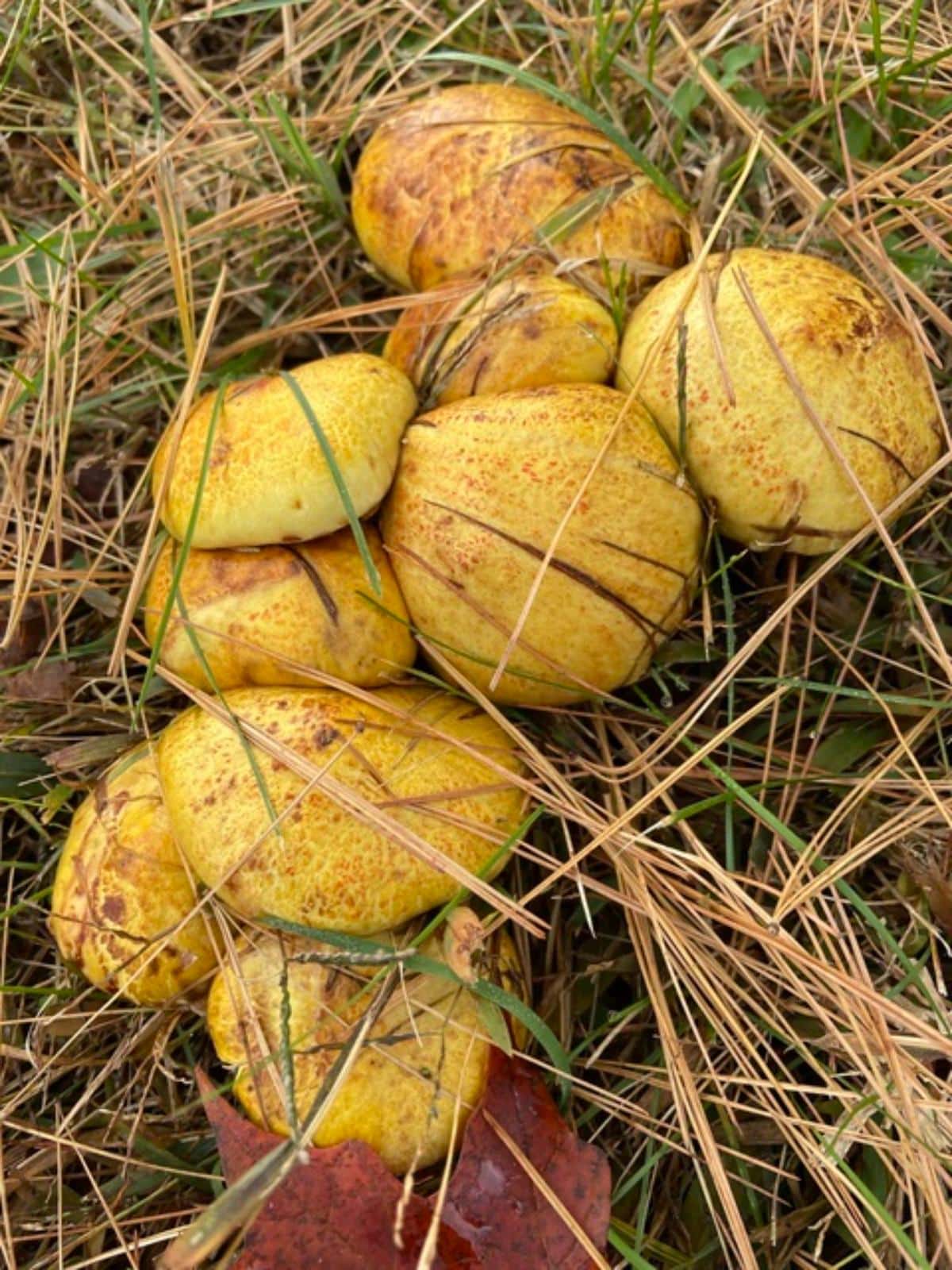
Chicken Fat Mushroom Identification Guide
Season
Look for these mushrooms during the months of July to October when they typically fruit.
Habitat
The chicken fat mushroom is commonly found in mixed coniferous forests, particularly in close proximity to 5-needled pines, and in particular eastern and western white pine trees. They also grow with limber pine, Swiss pine, and Siberian pine. Keep an eye out for patches of white pines and the long grass beneath them, as this is where the chicken fat mushroom likes to hide.
Chicken fat mushrooms grow from the ground, never on trees or from wood. They may appear singularly, in scattered groupings, or in dense expansive bunches.
This species is widespread across North America and is also found in China and (scarcely) in Europe. They appear wherever their preferred 5-needled pine tree hosts grow.

Identification
Cap
The chicken fat mushroom cap measures 1-4 inches in diameter and has a rounded shape when young, with edges that are rolled inwards. It gradually flattens out with age, then the edges turn upwards, sometimes turning wavy as it matures. The cap is slimy and sticky when fresh, a key recognizable trait. Its color ranges from very bright yellow to dull yellow, often featuring scattered red fibers and reddish-brown stains across the top. There is often white to yellow-brown veil tissue hanging from the cap’s margin.
When you handle the all parts of the mushroom, it will stain your fingers brown.
Pores
The chicken fat mushroom does not have gills. Instead, it has a pore surface on the underside of the cap. The pores are yellow and become brownish-yellow with age. The pores may bruise slowly brown or reddish-brown.
Stem
The stem of the chicken fat mushroom is slender and measures between 1-4 inches long. It is often crooked or bent and frequently hollow. The color of the stem varies from yellow above to brownish-yellow or brownish below. One key feature to look for is the presence of reddish-brown glandular dots on the stem. These dots may not be apparent on young specimens, as they blend in with the stem’s color.
Sometimes, a ring around the upper portion of the stem is visible, but more often, it is absent. The stem bruises slowly a reddish-brown color.
Flesh
When you slice into the chicken fat mushroom, you will notice its mustard yellow flesh throughout. In the stem, the color may be slightly darker yellow. The flesh may slowly stain pinkish when cut or not stain at all.

Odor and Taste
The chicken fat mushroom does not have a distinctive odor. The flesh has a slightly acidic taste.
Spore Print
The spore print color is cinnamon to brown.

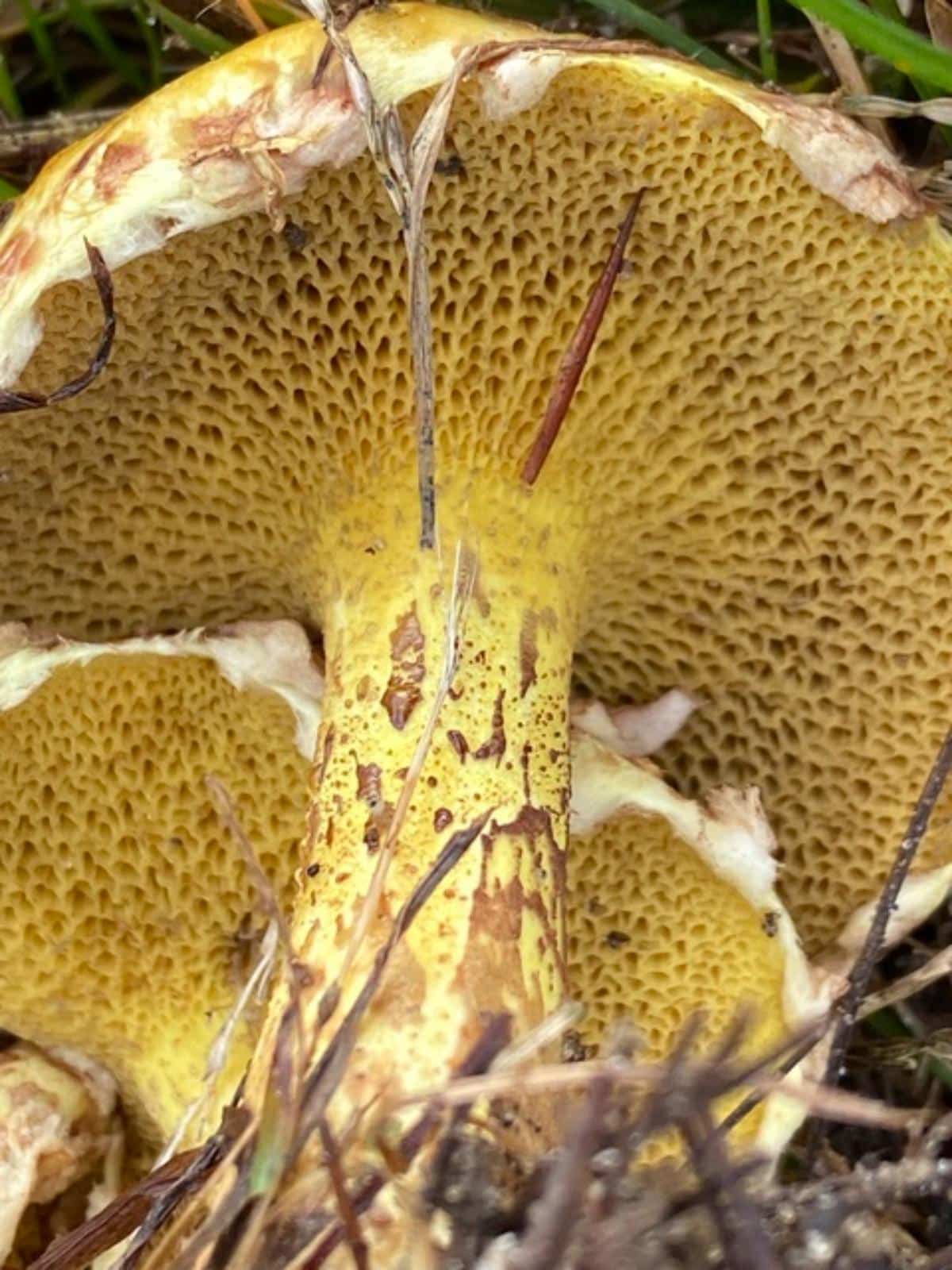

Chicken Fat Mushroom Lookalikes
Suillus flavoluteus
While it is said this mushroom has a duller yellow cap with more pronounced scales, it is also likely a synonym of S. americanus.
Spicy Suillus (Suillus punctipes)
This similar species doesn’t have red or brown markings on its cap and its pore surface is brown from the beginning, never yellow. It also grows with eastern pines, like the chicken fat mushroom, so its easy to confuse them from a distance.

Butterball (Suillus weaverae)
Butterball, aka S. granulatus (a primarily European species), is a cousin to the chicken fat mushroom and also grows with eastern white pines. The butterball’s cap, though, is more brown than yellow, and can vary from tan to yellow to cinnamon & red-brown. It is often streaked or checkered on top with brown markings. The pores also start out white and then turn yellow with maturity. This species is also a good edible.

Cooking and Preparing Chicken Fat Mushroom
The chicken fat mushroom offers a unique flavor profile that may not suit everyone’s palate. Some enjoy its rich taste and distinctive lemony tang, while others find its slimy texture akin to okra off-putting. Many people peel off the skin before preparing, to eliminate some of the sliminess. This is a bit time-consuming, but up to the consumer whether it’s worth it or not.
When cooked fresh, the mushroom is often described as bland or just unimpressive. However, when dried, it takes on a rich, woodsy flavor that makes it a great addition to various dishes. It’s also worth noting that the mushrooms should be cooked or dehydrated the same day they are picked as they become mushy and unusable quickly.
Drying: Chicken fat mushrooms can be dried to enhance their flavor. Slice them thinly, discard the stems, and place them in a dehydrator on the lowest setting. Alternatively, you can lay them out on a cookie sheet covered with parchment paper and use a fan to expedite the drying process. Once thoroughly dried, store them in a sealed container like a glass mason jar for long-term use.
Mix with other mushrooms: Due to their rich and somewhat sour flavor, chicken fat mushrooms can be mixed with other boletes, such as porcini or Leccinum, to create a blend of flavors. This can help balance out the intensity and add complexity to your dishes.
Cooking methods: While some may find the texture odd when cooked fresh, chicken fat mushrooms can be sautéed in garlic butter, cooked with wine and herbs, or stewed in meat stock. These cooking methods can help bring out the flavors and create a delightful culinary experience. If you leave the skin on and pan fry the mushroom, it makes the skin a bit crispy around the edges, much like a fried egg.

Medicinal Properties: Unveiling the Potential
While the primary focus of chicken fat mushrooms is their culinary use, there is emerging research on their potential medicinal properties. Preliminary studies suggest that chicken fat mushrooms contain a beta-glucan carbohydrate with anti-inflammatory properties. However, further research is needed to fully understand and harness the potential health benefits of this intriguing mushroom.
“Remember, mushrooms are nature’s treasure troves waiting to be discovered and savored!”

Chicken Fat Mushrooms Common Questions
Is the the chicken fat suillus bolete edible?
Yes, it is edible. See the cooking section in this post for preparation ideas.

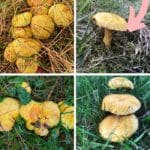



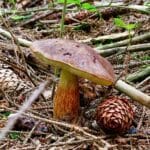
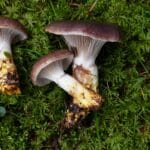


Michael J Bennett
All mushrooms are edible
Some only once